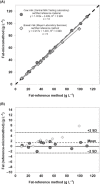Establishment of micromethods for macronutrient contents analysis in breast milk
- PMID: 23782538
- PMCID: PMC6860227
- DOI: 10.1111/mcn.12053
Establishment of micromethods for macronutrient contents analysis in breast milk
Abstract
Commercially available milk analysers were originally developed for use in the dairy industry, but they are now used to analyse macronutrient content of breast milk in clinical studies and routine care of the premature or very low birthweight (VLBW) infants. Due to the different composition of cow and breast milk, these devices need to be validated against reference methods before they can be used in daily routine. However, current reference methods require a sample volume of 30-100 mL to analyse fat, protein and lactose. It is not feasible to obtain this volume of milk for research purposes, especially from VLBW infants as lactation may be delayed or impaired and the limited volume of breast milk must be provided to the infant. To support validation of milk analysers in both clinical and research settings, the aim of this study is to establish and validate micromethods for precise macronutrient analysis in small volume of breast milk and conduct a feasibility study of the micromethods as a post-validation. Methods include a modified Mojonnier ether extraction (fat), elemental analysis (protein) and ultra-performance liquid chromatography-tandem mass spectrometry (lactose). We were able to downsize volumes required for analysis of fat, protein and lactose to 1 mL, 260 μL and 100 μL; corresponding coefficients of variation are 1.7, 1.8 and 2.3%, respectively. The presented methods allow for reliable and precise analyses of macronutrients in ≤1.5 mL of breast milk and will be used to validate milk analysers.
Keywords: breast milk; macronutrients; neonatal nutrition; preterm infants; quantitative methods; validation.
© 2013 John Wiley & Sons Ltd.
Conflict of interest statement
The authors declare that they have no conflicts of interest.
Figures


 ) and Central Milk Testing Laboratory (
) and Central Milk Testing Laboratory ( )] vs. the modified Mojonnier ether extraction micromethod (dash line indicates line of identity); (B) Bland‐Altman plot shows the differences between fat values obtained by reference laboratories and micromethods represented in the Y‐axis. The results obtained using the reference values are represented in the X‐ axis.
)] vs. the modified Mojonnier ether extraction micromethod (dash line indicates line of identity); (B) Bland‐Altman plot shows the differences between fat values obtained by reference laboratories and micromethods represented in the Y‐axis. The results obtained using the reference values are represented in the X‐ axis.
 , total protein
, total protein  )], Meyer Laboratory Services (
)], Meyer Laboratory Services ( ) and Central Milk Testing Laboratory (
) and Central Milk Testing Laboratory ( ) vs. Elemental analysis micro‐method (dash line indicates line of identity): (B) Bland‐Altman plot shows the differences between fat values obtained by reference laboratories and micromethods represented in the Y‐axis. The results obtained using the reference values are represented in the X‐ axis.
) vs. Elemental analysis micro‐method (dash line indicates line of identity): (B) Bland‐Altman plot shows the differences between fat values obtained by reference laboratories and micromethods represented in the Y‐axis. The results obtained using the reference values are represented in the X‐ axis.
References
-
- American Academy of Pediatrics, Committee on Nutrition (2004) Nutritional needs of the preterm infant In: Pediatric Nutrition Handbook (ed. Kleinman R.E.), 5th edn, pp 23–54. American Academy of Pediatrics: Chapel Hill, NC.
-
- AOAC International (2006) AOAC official method 989.05 fat in milk: modified Mojonnier ether extraction method In: AOAC international (ed. Horwitz W.), p 33.2.26 AOAC International: Gaithersburg.
-
- Arslanoglu S., Moro G.E. & Ziegler E.E., The Wapm Working Group On Nutrition (2010) Optimization of human milk fortification for preterm infants: new concepts and recommendations. Journal of Perinatal Medicine 38, 233–238. - PubMed
-
- Barbano D.M., Lynch J.M. & Fleming J.R. (1997) Direct and indirect determination of true protein content of milk by Kjeldahl analysis: collaborative study. Journal of the Association of Official Analytical Chemists 74, 281–288.
-
- Bergqvist Y., Karisson L. & Fohlin L. (1989) Total protein determined in human breast milk by use of coomassie brilliant blue and centrifugal analysis. Clinical Chemistry 35, 2127–2129. - PubMed
Publication types
MeSH terms
Substances
LinkOut - more resources
Full Text Sources
Other Literature Sources
Medical

